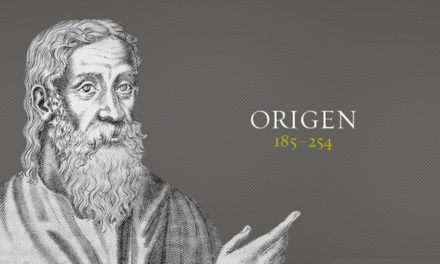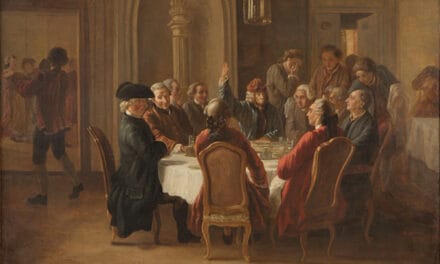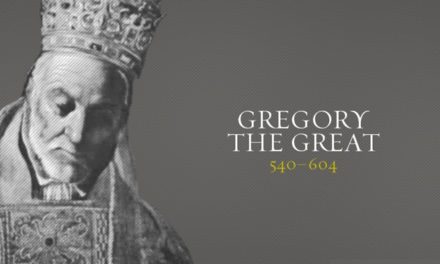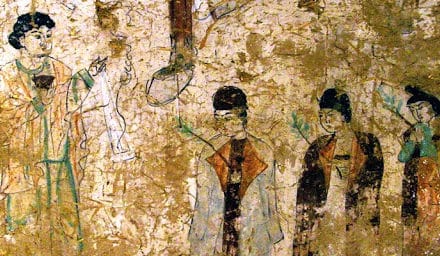One of the features of Church History is the tendency for the theological pendulum to swing to one extreme, then back in the other direction to another. At the risk of being simplistic but in an attempt to keep it brief, let me condense things like this . . .
The theological discussion of the early church struggled first with how to understand Jesus and His place in the Godhead; His identity as both God and Man and how both the Son and Holy Spirit related to the Father in the Trinity. Nailing that down with just the right terminology, they then dove deeper into Who Jesus was, seeking to understand how his identity as both God and Man related to each other. All that was the subject & theological fodder for the first great Church Councils and their Creeds that have for the most part come to define Christian Orthodoxy.
But theologians didn’t all then hang up their scholarly hats and sail off to a tropical isle to lounge in beach chairs and sip fruit drinks with little umbrellas. They kept on theologizing; and theologizing and then theologizing some more. They made a list of all the things people wondered about related to the faith and went in search of answers. When they ran out of questions, they started making new ones up about things people had NOT been wondering over – like, how many angels can dance on the head of a pin? And, why would an angel WANT to dance on a pin’s head? How big should a pin’s head be? à You get the idea.
This period of theology began in the 12th C as a part of Medieval Theology and is known as Scholasticism. Some of the names associated with Scholasticism are Anselm, Abelard, Duns Scotus, William of Ockham, and the Big Daddy of them all Thomas Aquinas who lived during the 13th C.
The problem with Scholasticism is that it became a purely academic movement that appealed only to intellectuals. Theology became the realm and prerogative of an elite class of highly educated academics. Gone were the days when theology touched the lives of the common people and informed them about their relationship with God. PRACTICAL theology was set aside in favor of theoretical ponderings on philosophical details. Commoners were too busy trying to survive to pay attention to all that. The Middle Ages in Europe saw a growing disconnect between theology and the common man. Priests, who’d been the interface between the workaday world and the Church, were torn between competing pulls. One pull was the desire to minister to commoners with their needs, pedantic & mundane as they often were. The other attraction was the desire to be honored among their theological peers as a learned & erudite man of the cloth. While some priests eschewed the later appeal in favor of keeping it simple and ministering to the needs of common people, many others succumbed to the draw of the hallowed halls of academia and Scholasticism.
The result was that path leading to a moribund church needing renewal and reform we looked at in Season 1 in the series “The Long Road to Reform.”
So the theological pendulum swung in Scholasticism way out toward a purely academic philosophizing. Then in the Reformation swung back toward Scripture as the basis of Faith and practice. But the Reformation didn’t produce a single brand of Protestantism; it launched a bunch. Each of them took on the task of justifying itself as the right one; most faithful to Scripture. Reformation theologians embarked on a kind of Protestant Scholasticism; at first producing pamphlets, then books and finally several volumes defending their views and attacking others. Polemics, that is works attacking other positions were frequent among Protestant theologians after the Reformation. A polemic became the cause of a reply, which itself would turn to a polemic, which would call up more responses. It was a War of Words & Ideas. Fought with the ammunition of paper & ink, and eventually, with real swords and spears and cannons as lines were drawn and being a heretic became just cause for killing.
Just as Catholic Scholasticism helped paved the way for the Reformation, it was inevitable Protestant Scholasticism would prompt its own Response. It came in what’s called Pietism, regarded by some as the most important movement between the Reformation and theological liberalism.
The first stirrings occurred among Calvinists in the late 16th & 17th C in the Northern European reaches of the Netherlands & Germany mainly among Lutherans. It’s main leaders were German Lutherans; Philipp Spener, August Francke, and Nikolaus von Zinzendorf. It was picked up and carried along by John and Charles Wesley, founders of Methodism.
By the middle of the 17th C, Protestant dogmaticians defined the fundamentals of saving faith in such elaborate detail no one but an advanced scholar could hope to know them. Theology, which the Early Reformers delighted to return to the common man was once again being sequestered in the skulls of academics. Luther used theology to reform public morality in Wittenberg. Calvin did the same far more systematically in Geneva. Both had the support of the State & a large part of the population. But by the end of the C, it looked like the Reformation had stalled. With rare exception, both nobility & commoners were as immoral as before the Reformation.
What came eventually to be called Pietism began simply as several uncoordinated efforts on the part of pastors to get their people to live out what they claimed to believe. There was no thought among these church leaders to start a movement and give it a distinctive label people would write books and do podcasts on hundreds of years later. They didn’t think of it as “Pietism;” they considered it normal Christianity – Following Jesus.
A forerunner of Pietism was John Arndt. Arndt resisted the trend of his day for pastors to pursue heady theology & advocated instead an intense pursuit of a personal, real, warm relationship with Christ. It wasn’t that Arndt rejected theological educations and discussions. It’s just that he felt they’d become a substitute for a genuine walk with God. His ideas quickly took root and moved other pastors to a similar message.
The first Pietists regarded themselves, not as innovators, but as heirs of Luther. They weren’t launching some new movement; they were getting back to Martin. Pietism did develop distinctive emphases that set it apart from the emerging Lutheran orthodoxy. By far its most important emphasis was its belief in each Christian having a conversion experience in which they were born again. Pietists believed they had more than sufficient warrant for this in what Jesus said to Nicodemus in John 3 – “You must be born again.” That was NOT an emphasis in standard Lutheranism.
Pietism was intensely personal. It urged people to take their commitments as a sacred oath & obligation. In so doing, it made them better members of society and so came to the attention of civil rulers as a useful tool. So it was encouraged.
Pietism never became an established church or denomination. Rather, it was a movement that infiltrated most of the Protestant groups of Europe and aboard. It was the Pietistic urge to walk humbly with God that launched may of the distinctives that have marked a vibrant Evangelical Faith. Things like Bible printing and distribution, foreign missions, orphanages & schools, hospitals & ministries for the disabled & elderly. Pietists did all they could to fulfill the commandments to love God & others, and to carry the Gospel to the lost.
But, and here’s where the swinging pendulum ran too far with the Pietistic reaction to Protestant Scholasticism—In the move to prove true faith changes lives, some Pietists embraced the slogan “Life, not doctrine.” Instead of a balanced Both/And, they advocated an Either/Or that pitted theology against behavior.
Orthodoxy & Orthopraxy were divorced.
This indifference to doctrine saw Pietism becoming an unwitting ally to the Enlighten-ment’s attack on the Central Truth claims of Orthodox Christianity. Then it helped fuel the sentimentalism of the Enlightenment’s own pendulum swing into Romanticism.
With Pietism’s emphasis on the individual experience of conversion and a personal walk with God, the sense of Christian Community took a massive hit as well. Jesus wasn’t just the Savior of the world, He was now a PERSONAL Savior; the Savior of ME, rather than US. So, one of The Gospel’s greatest attractions, the priority & reality of restored love for God and others that had been so appealing since the first days of the Church, was diluted. Under a maturing Pietism, Christianity went from being a Faith that called people into community through a mutually shared life, to more of an individualistic focus on one’s personal experience of conversion & a daily walk with God.
A thoughtful reflection on modern Evangelicalism, especially as evidenced in North America, reveals the many connections to Pietism. Many, maybe most, independent Protestant churches are thoroughly pietistic. Much of crusade-style evangelism flows from the pietistic urge to promote a conversion experience.
So, some might ask – Why are we talking about Pietism in a series on Heretics and Heresy?
Good question.
Pietism itself isn’t heretical, not even close. But its history reveals an important truth the wise will glean. In emphasizing one thing, there’s the tendency to de-emphasize another. When balance is lost to the swinging pendulum of trends in human society, a door is opened to errors that can do great harm.
Pietism’s emphasis on personal conversion and the individual’s walk with God became an unwitting ally to the Enlightenment’s assault on historic, orthodox Christianity. It helped pre-position hundreds of thousands for the sentimentality, emotionalism, and anti-intellectualism of Romanticism.
Pietism is one of many reminders that a good thing can become a bad thing when it’s not carefully made to be a balanced thing.






Love the way you’re doing this second season of Sanctorum. I hope you will take such a deeper look at the various controversies such as the trinity and Christ’s divinity and natures. I’d love a more thorough discussion on them by you.
Regardless, I am enjoying this new season and hope for 50 more seasons to come.
Andy, we’ll see.
‘Twould be great.
Ahhhh…. and now we come to it! This episode now sheds light on my own personal inner “Perfect Storm” between my love of BIBLICAL THEOLOGY, my PERSONAL walk of faith, and what I will refer to as my understanding of New Testament COMMUNITY. I don’t think I would have ever seen it’s roots in Pietism, not knowing much about it, but it explains so very much, not only in my own life, but in the landscape of the church as I have observed almost all my Christian life (nearly 40 years). I’ve often wondered why there was such an inner conflict between aspects of my faith that should have worked seamlessly together. The revelation of history explains much!
Lem,
I read your comment to my wife over dinner last night.
THIS is why I do CS in the first place.
I can die in peace now.
🙂
Be at peace… but put off the dying part for a while; you’ve still got work to do. 😉
🙂
Great work Lance. As you point out, we need experiential knowledge of God and intellectual knowledge. I like to relate it to the text following the Shma’ in Dt. 6:4. What follows in ;5, “An you shal love the Lord your God with ALL of your heart, soul, and strength. i.e. -with all you’ve got. So it is not just my emotions that are involved it is my intellect and everything in between. It is an all encompassing worship. Would that we bear his image in such a way. Blessings.
Thanks James